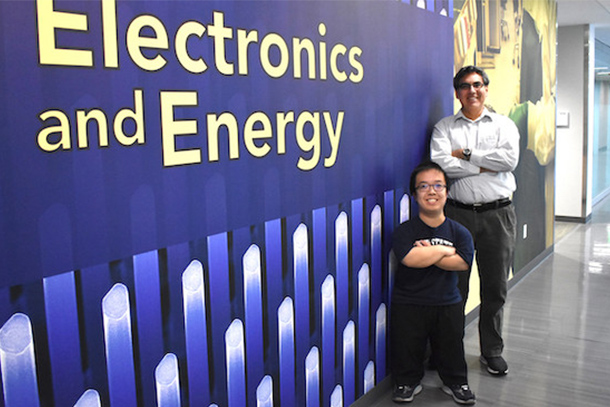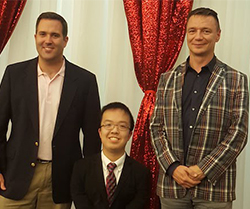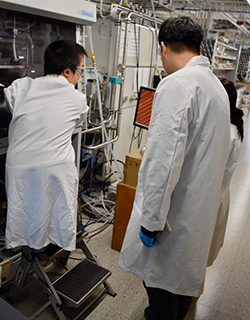
James Sutjianto (left), doctoral candidate in chemical engineering at Penn State, and Enrique Gomez, professor of chemical engineering and materials science and engineering. Image: Jamie Oberdick
Graduate student of short stature overcomes challenges in lab, life
Doctoral candidate in chemical engineering aims to inspire those with disabilities to enter STEM fields
10/21/2019
By Jamie Oberdick
UNIVERSITY PARK, Pa. — James Sutjianto, doctoral candidate in chemical engineering at Penn State, was one of 24 Penn State graduate students in 2019 who were selected for the National Science Foundation Graduate Research Fellowship Program (GRFP), given to students who have “potential for significant research achievements.” An impressive accomplishment, one that is even more impressive when considering Sutjianto had to overcome a challenge the other students did not: He is a person of short stature.
“As someone who is afflicted with achondroplasia, which is short stature, I have had to endure multiple trials that average height individuals do not have to face,” Sutjianto said. “I endured three difficult spinal fusion surgeries in high school and during my undergraduate time. I also live in a world made for average height people.”
Although Sutjianto had multiple setbacks because of his physical frame, he was able to persevere through them.
“My biggest career goal is to encourage individuals with disabilities to take on a career in the STEM (science, technology, engineering, and mathematics) field,” Sutjianto said.
Sutjianto works in the lab of Enrique Gomez, professor of chemical engineering and materials science and engineering with a co-appointment in the Materials Research Institute. He researches the design, synthesis and characterization of conductive polymers for flexible electronics.
“James is a very talented student who has remarkable perseverance,” Gomez said. “He approaches problems and challenges with a great attitude and optimism.”
In Gomez’s lab, James works on designing new organic molecules that could lead to use in flexible displays, printable solar cells, biosensors for diagnosis of diseases and stimulation devices for nerve regeneration.
Research inspiration from a difficult experience
In fact, an inspiration for Sutjianto’s choice of flexible electronics as a research focus is based on an adverse experience after one of his spinal fusion surgeries. Spinal surgery is often necessary for individuals with short stature due to kyphosis or scoliosis, which are abnormal curves in the spine. Kyphosis is a forward curve, and scoliosis is a sideways curve, and both are common in people with short stature.
As a child, a person of short stature often has to wear a body brace, and as the person nears adulthood, they often undergo surgery to straighten the spine. Metal bars are inserted into the patient’s body to keep the spine from bending.
In Sutjianto’s case, three surgeries were required to straighten his spine, starting while he was a high school student in Houston, Texas. After his first spinal fusion surgery, he could not walk for several weeks. He had to use an electrostimulation device to “wake up” his nerves so that he could walk again, and he points to this experience as a revelation that greatly influenced his choice of graduate research focus.
“After remembering the jolts of current that was applied to my skin to wake up my nerves, it dawned on me that I wanted to also design materials that can be used for nerve regeneration applications,” Sutjianto said. “This is so people who experience the same pain and anguish that I experienced due to not being able to walk can be healed quicker and more efficiently.”
The third one replaced one of the metal bars after it snapped, and he had it right before he received his bachelor of science in chemical engineering from the University of Houston. This was another experience that influenced his future research, as he began to think about possible solutions to preventing future issues with metal implants that break in the human body.
“In polymers, we can develop materials that are flexible and stretchable,” Sutjianto said. “I wanted to help develop materials in the human body that are not brittle but have the same structural strength as a metal. It will bend to the natural intent of the human body, but it won't break. If you bend a metal bar with enough force, it cracks. But if you take a flexible material like a polymer, it naturally will bend but won't break right away.”
Overcoming challenges in the lab
Via a combination of his own ingenuity and help from colleagues, faculty and the University, Sutjianto has overcome a variety of challenges to conduct his research.
Sutjianto is an experimentalist, and he spends most of his time in the lab. For the lab bench, he uses a two-step stool to attain height, but a lot of work in polymers requires an air-free environment. This requires a glove box – a sealed container with long gloves built into the sides that enable the user to perform tasks in the box without breaking containment.
“For a normal height individual, using a glove box already is a pain because we have limited dexterity since our hands are in these long gloves,” Sutjianto said. “But for me, it took some tinkering around, with assistance from a helpful adviser like Dr. Gomez and a really good group of colleagues who advised me on what to do. I was able to adapt to it.”
For example, Sutjianto said, having reaching tools inside the glove box enables him to access shelves that have items needed for the experiment.
“Using a glove box is one of the most challenging aspects for someone with short arms and legs, but there are adaptions you can come up with,” Sutjianto said. “You just have to think about it correctly and you can be just fine. And know there are always colleagues willing to help.”
Sutjianto also praised Penn State’s Student Disability Resources office for offering help with adapting classroom spaces to meet his needs.
“We have a really good student disability office at Penn State,” Sutjianto said. “I'm really grateful, they are an active group who I’ve talked and discussed needs with multiple times. They are very responsive and helpful.”
Achieving in STEM with a disability
His colleagues, the chemical engineering faculty, and the University’s willingness to help, Sutjianto said, have been an inspiration to him. He said that this was not always the case for people with disabilities such as short stature seeking out careers in STEM.
He recounted that while preparing his own personal statement for graduate school, he read an article about people with disabilities in the STEM field.
“It's interesting and heartbreaking at the same time that a lot of people with physical and mental disabilities are retracted from STEM because of their disability,” Sutjianto said. “A lot of people look down on them already and say, ‘Oh well, you don’t have the physical and mental capabilities, so you can't really do this.’ I find that completely bogus because you’re separating talented people from what they can actually do.”
Sutjianto said he was grateful to Gomez for his support, and he offered simple advice for faculty who may have a person of short stature in their courses.
“Be understanding of the short stature person and make sure they are physically comfortable in their seating and in labs,” he said. “Do what you can to make sure they are comfortable enough to be able to focus in class, and work with Student Disability Resources to come up with solutions.”
For others with disabilities who are thinking of pursuing STEM-related higher education, his advice also was simple: follow your dream and do not give up.
"Although I had multiple setbacks because of my physical frame, I was able to persevere through them, including landing a GRFP fellowship,” Sutjianto said. “I want to be an inspiration to individuals with disabilities because although disabilities make us different, we can still make an impact in the STEM field.”





